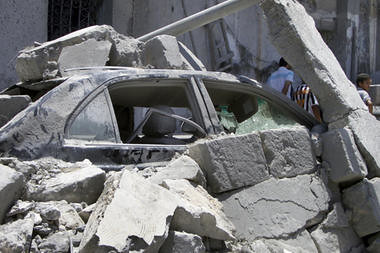
In this photo taken on a tour, a damaged car lies underneath rubble opposite a damaged residential building in Tripoli, Libya, Sunday, June 19, 2011. The US and Europe are justifying the carnage., a photo by Pan-African News Wire File Photos on Flickr.
Libya Is Air Show for Defense Firms
By DANIEL MICHAELS
Wall Street Journal
LE BOURGET, France—At the Paris Air Show this week, cutting-edge fighter jets are performing aerobatic routines designed to sell their flying abilities. More than a thousand miles to the south, those same planes are putting on a more realistic show.
Lessons from the air war to unseat Libyan strongman Moammar Gadhafi could end up having a bigger impact on military sales than all the marketing at the Le Bourget airfield outside Paris, industry officials say. And it isn't just the jets that are getting attention—helicopters, drones and other weapons are, too.
With European forces leading the fight, equipment from defense giants including Britain's BAE Systems PLC, Franco-German European Aeronautic Defence & Space Co. and Italy's Finmeccanica SpA is playing a key part. U.S. equipment from defense titans Lockheed Martin Corp., Boeing Co. and Raytheon Co. is also playing a central role, even though U.S. troops aren't in combat.
Europe's three latest fighter planes have been air show stars for years. Now, in Libya, the pan-European Eurofighter Typhoon, French Rafale and Swedish Gripen are operating together for the first time, alongside older American and European jets. The planes' performance could have commercial implications, as European governments struggle with deep budget cuts.
For example, India is deciding between the Eurofighter and the Rafale. Indian officials are watching the Libyan conflict, industry officials say, so the planes' makers are using the air show to talk up their products' performance in Libya. "Everyone who is watching what's going on in Libya is very impressed by Rafale's reliability and accuracy," said Charles Edelstenne, chairman and chief executive of Dassault Aviation SA, which makes the plane, in an interview. The Eurofighter's makers are boasting about their plane in turn.
Brimstone missiles from the pan-European maker MBDA were on display next to the Rafale, even though they aren't used on it. The message: These products could go together. Mr. Edelstenne said it was up to the French government to equip the plane with the missile.
While new fighter jets are prominent defense assets, both at the air show and on the battlefield, many older and smaller weapons are proving at least as useful in battle. Some are doing jobs the pricey jets can't. Attack helicopters such as Boeing's Apache and the Tiger, an air show regular produced by EADS unit Eurocopter, have recently entered the Libyan fray. They can get closer to land targets than most fast jets can.
A combination of drones, missiles and electronic systems on display around the trade show is also playing an important role in Libya. Such equipment helps forces from the North Atlantic Treaty Organization distinguish government troops from rebels fighting in close quarters, often using similar improvised vehicles, and target only the government forces.
At the same time, the Libyan battle shows that European arms buyers have focused too much on big-ticket procurements like fighter jets, analysts and industry officials say. Nimbler systems for collecting intelligence and fighting urban wars still lag behind U.S. capabilities.
"One of the lessons that will probably come out of Libya is that Europeans need to fill this capabilities gap faster than they have been," said Douglas Barrie, senior fellow for military aerospace at the International Institute for Strategic Studies, a think tank in London.
Defense companies have long tried to interest Europe's military buyers in unmanned aerial vehicles, for instance. The U.S. has used UAVs effectively in Iraq and Afghanistan.EADS has been working on one, called Talarion, for many years, but governments haven't bought any. "Governments say they want UAV capabilities, but they have no money," said Stefan Zoller, chief executive of EADS's defense subsidiary, Cassidian.
Libya may be changing that. Britain and France this month announced plans to jointly develop a UAV called Telemos. The two countries, which together account for more than half of all European defense spending, tapped BAE Systems and Dassault Aviation to develop it. The companies say they hope to work efficiently by pooling know-how and funding.
Another area where modest systems are proving valuable is munitions. Many of the large and fast missiles that Europe developed at the end of the Cold War are too explosive for targets in Libya.
Instead, a very precise version of the Brimstone missile is proving to be one of the most useful weapons in the battle, because it can destroy small targets without causing death or damage nearby. A top official of Britain's Royal Air Force, which uses the Dual Mode Brimstone in both Afghanistan and Libya, recently said French and U.S. defense buyers had expressed interest in it. A person close to MBDA, which is owned by BAE, EADS and Finmeccanica, confirmed it had received inquiries.
"If there is a star of this conflict, it's Brimstone," said Francis Tusa, editor of Defence Analysis, a British monthly.
Write to Daniel Michaels at daniel.michaels@wsj.com
No comments:
Post a Comment